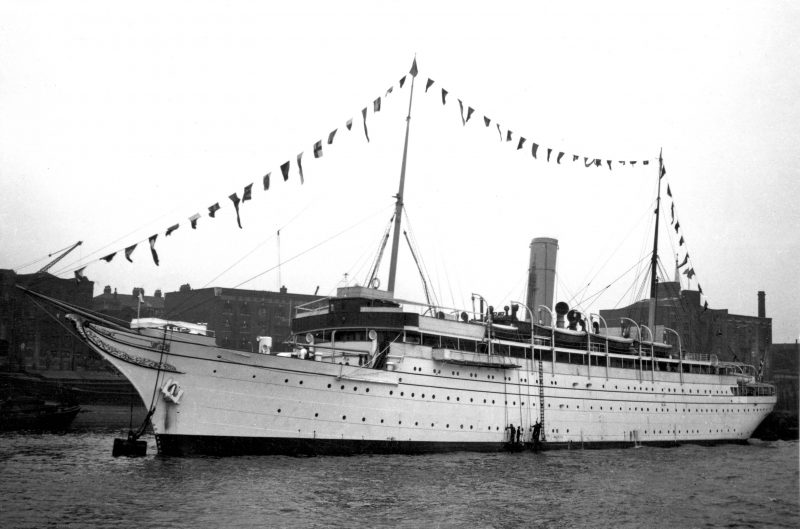
The winner of the October competition was AD Frost of Sunderland
AD Frost writes:
October’s Unknown Ship is Bergenske Dampskibs-selskab, A/S Det. (Bergen Line) cruise ship Meteor, built 1904 by Blohm & Voss. In 1942 she was renamed Rostock, then Meteor II .Bombed and sunk off Pillan 9.8.42.
Robert Langlois writes:
The ship depicted in the October edition is the cruising yacht Meteor, completed in 1904 by Blohm & Voss, Hamburg for the Hamburg-Amerika Line, for the specific purpose of cruising the Norwegian Fjords. Her gross tonnage was 3,613, with a small deadweight of 1,500, on dimensions of 328.8’ (367.5’ oa) x 44.3’, and she catered for just 283 firstclass passengers. Her twin screws were driven by 3-cylinder triple-expansion engines of 1,550 indicated horse-power, giving a service speed of 14 knots. During the First World War, the Meteor was taken over by the German Navy, and used as an accommodation ship for U-boat crews and as an auxiliary minelayer. In May 1919 she was ceded to the Allies, and allocated to the UK Shipping Controller (Royal Mail Line as managers), repatriating British troops from Argentina, Ceylon, Burma and India. In 1921 she was sold to the Bergen Line of Norway without change of name, becoming their second Meteor, and reconditioned for cruising from the Tyne to the North Cape, while occasionally relieving on North Sea routes.
Cruising ceased with the outbreak of the Second World War, but she continued to ply the North Sea. On 15th October 1939 she was intercepted in the North Sea by Prien’s U-47, which was returning to base after sinking the British battleship Royal Oak in Scapa Flow, but as a neutral allowed to proceed. In May 1940, she was captured at Bergen by the invading German forces, and refitted as a hospital ship with 200 beds. As such she operated initially in Norwegian waters, being renamed Rostock in March 1942, but soon changing again to Meteor II two months later. In March 1945, while assisting with the evacuation of civilians from East Prussia, she was bombed by Russian aircraft off Pillau, and capsized and sank with the loss of 24 lives. Meteor was notable as one of the earliest ships to be purpose-built for cruising, with white hull and bowsprit to provide a yacht-like appearance. One source says that during her time under the Shipping Controller (1919-21) her hull was painted black and the bowsprit removed, but I have seen no firm confirmation of this. I surmise that the mystery picture was taken in the years leading up to the First World War, by which time the original distinctive outward- curving top rim of the funnel had been removed. This feature had first appeared on the funnels of Meteor’s earlier consort Prinzessin Victoria Luise of 1900, generally considered the world’s first purpose-built luxury cruise ship, which had been lost in December 1906.
John Jordan writes:
I believe this is the 1904 Hamburg Amerika line cruise ship Meteor. She was designed for Norwegian fjord cruising and built by Blohm and Voss. She may have made at least one cruise to the Mediterranean. She was ceded to Britian in 1919 but later returned to Scandavian cruising. She was known to have cruised with a larger look-alike Stella Polaris, for Norwegian Bergen Line. Records indicate she was sunk by aircraft in 1945 while acting as a German hospital ship.
Alan Blackwood writes:
This month’s unknown is the graceful and yacht like twin screw 12.5 knot steamer Meteor completed during 28th May 1904 by Blohm & Voss Schiffswerft und Machinenfabrik at their Steinwerder, Hamburg yard to the order of the Hamburg Amerika Line, for operations primarily on European cruise services. Initially of 3,613 grt, her dimensions (LBP) were 328’09” x 44’3.5″ (100.2 x 13.5m).
At the outbreak of WWI, she was requisitioned by the German Navy for utilisation as a submarine accommodation vessel, based at the small port of Eckenforde, some 16 NM north of Kiel. Following the Armistice, she was handed over to the UK Shipping Controller on 30th May 1919 as a war reparation and reportedly placed under the management of the Royal Mail Line until 1921 when her registered ownership was transferred to Henry J. Jewell of London.
During 1922 Meteor was acquired by A/S Det Bergenske D/S (The Bergen Line) for operations mainly as a 300 passenger cruise vessel, in time gaining such popularity and reputation for excellence, as to encourage her owners to order a somewhat larger vessel, but for worldwide cruise operations – the particularly elegant clipper bowed Swedish (Gotaverken) built 5,020 gross ton twin screw motorship Stella Polaris, delivered during February 1927.
Following the WWII German invasion of Norway, Meteor was seized at Bergen by the German Navy during 7th May 1940 and converted for the role of hospital ship to the Kriegsmarine, being renamed during 1942 as Rostock, but later that year further renamed Meteor II. On 9th March 1945 she was bombed and sunk by Russian aircraft as she lay at the U-boat training facility at the small Baltic port of Pillau (now Baltiysk, Kaliningrad).

George Flint writes:
My guess is Stella Maris.
Johnny Magne Holmen writes:
The Ship is identified as the steam-yacht Meteor (callsign: LCTO/LCQF). She was built as a cruise ship for the German shipping line Hamburger-Amerikanische Paketvart AG (often shortened to HAPAG) in 1904. She was build no. 170 by the German shipyard Blohm & Voss AG in Hamburg. Meteor was built to go in cruise along the Norwegian, Baltic and European coastal waters, and after completion by the yard in May 1904, the ship was put into the tourist traffic. After the outbreak of 1st World War I in 1914, the ship was requisitioned by the Imperial German Navy and used as accommodation ship.
In 1919, she was taken as a war prize by the United Kingdom and her use was manged by Royal Mail Packet Co.Ltd in London.
In March 1921, Meteor purchased by the Bergen Line, Bergen (BDS), but was registered under H.J. Jewell in London. In June 1922, the ship was registered in Norway with Bergen as home port. The purchase price was 1.3 million. During the summer months Meteor cruised along the Norwegian coast, and the summer of 1930 she sailed with BDS other tourist yacht Stella Polaris to Iceland on the occasion of the country’s 1,000 year anniversary. The design of Stella Polaris, Bergen Lines most famous passenger liner/cruiseship, was based upon the Meteor and the experiences Bergen Line had with her. In 1935, the ship was upgraded with better staterooms, new lady lounge and improvement of the machinery. In 1939 she got a new radio.
During the German attack on Norway 9th April 1940, Meteor was in layup in the port of Bergen. On 27th April, the ship was seized by the German occupying forces and redecorated to hospital ship service. The conversion resulted in much of the interior was destroyed when it was made room for sick bays and operating theatres. Meteor served in the Baltic Sea, but had a Norwegian crew. In March 1942 she was renamed Rostock. Two months later she was again renamed, this time to Meteor II. Just at the end of WW2, on 9th March 1945, she was sunk by Soviet aircraft at Pillau. Despite the fact that she was labeled as hospital ship. 24 people were killed, four of them were Norwegians.
Meteor’s tonnage as delivered was 3,718 gross tons, 1,883 net registered tons with a cargo capacity at 1,500 deadweight. She had two triple expansion steam engines that drove each propeller, and that each had a coal-fired boiler. Declared yield was 1550 indicated horsepower and 235 nhk (nominal horsepower) for each of steam machines, which gave her a top speed of 12 knots. Upon delivery was passenger capacity 250. After rebuilding in 1935 was passenger capacity was reduced to 205, but in return had all staterooms now been fitted with cold and hot water.
Mike Goadby writes:
This month’s unknown ship is the 3,717 grt cruise ship Meteor built in Hamburg by Blohm und Voss for Hamburg America Line (HAPAG) in 1904. Powered by triple expansion engines which gave her a speed of 11.5kts. Requisitioned by Kaiserliche Marine and used as accommodation vessel, handed over to Great Britain in May 1919 , run by Royal Mail Steam Packet Co.Ltd, London. Purchased by Det Bergenske in March 1921, registered under H.J.Jewell, London, at first, then registered in Bergen from June 1942. The vessel as rebuilt at Laksevag in 1935. Attacked by Russian aircraft on March 9th 1945 at Pillau harbour, capsized , out of a crew of 70 Norwegians 24 died in this incident.
Harold Lincoln writes:
The Mystery Ship in the October edition is the Stella Polaris, 5020 GRT, built 1927. Her details were: Purpose designed cruise ship built by Götaverken, Göthenburg, Sweden, for Bergen Line of Norway. Launched September 1926, completed February 26th 1927. Passenger accommodation for 200 which reduced to about 100 on world cruises. Seized by Germany in World War II and used as accommodation for U-Boat crews. Returned to Bergen Line in 1945 and refitted by Götaverken. Returned to cruising. Sold to Swedish Clipper Line in 1952, continued luxury cruising. Sold Japanes interests 1969 and used as floating hotel in Japan. Sank September 2nd 2006 while under tow to Chinese shipyard where she was to be refitted as a floating hotel and restaurant for use in Stockholm.





Comments
Sorry, comments are closed for this item